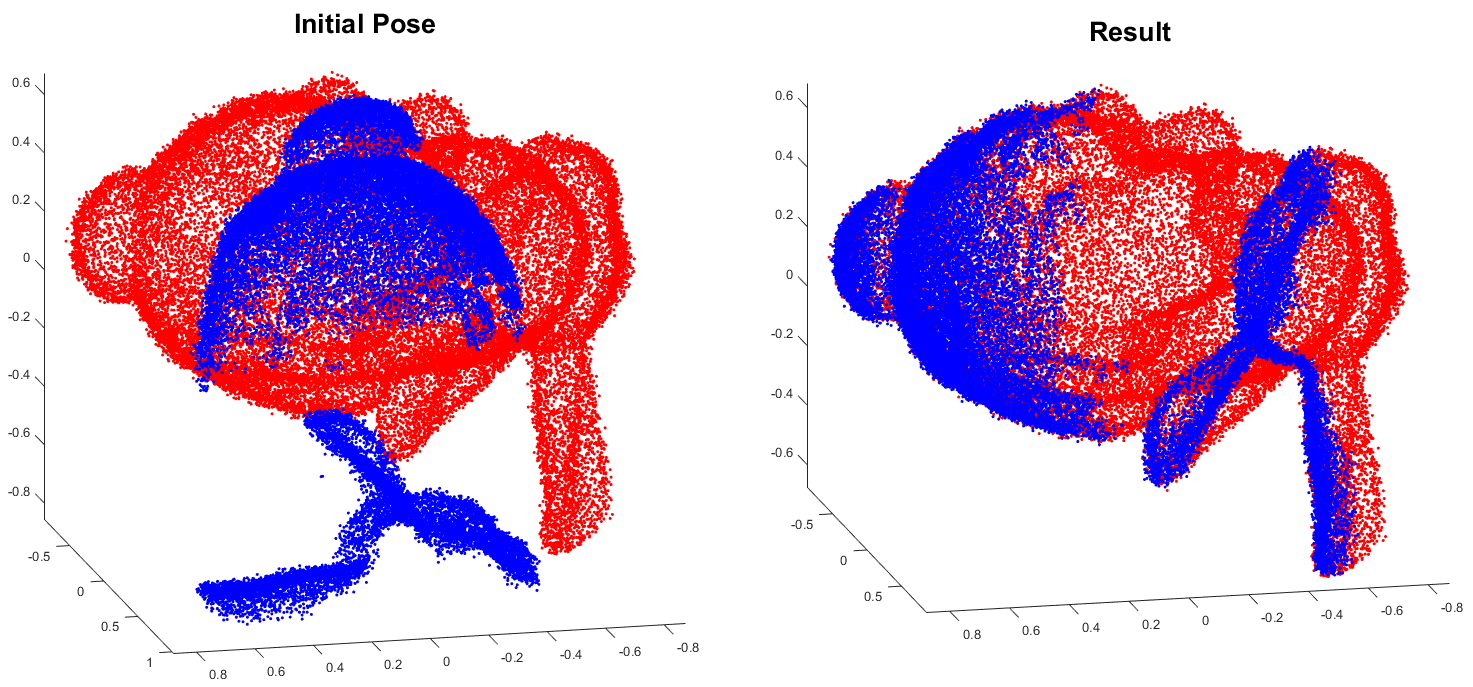(A demo video can be found on here.)
This repository contains the C++ code for the Go-ICP algorithm (with trimming strategy for outlier handling). It is free software under the terms of the GNU General Public License (GPL) v3. Details of the Go-ICP algorithm can be found in our papers:
-
J. Yang, H. Li, Y. Jia, Go-ICP: Solving 3D Registration Efficiently and Globally Optimally, International Conference on Computer Vision (ICCV), 2013. PDF
-
J. Yang, H. Li, D. Campbell, Y. Jia, Go-ICP: A Globally Optimal Solution to 3D ICP Point-Set Registration, IEEE Transactions on Pattern Analysis and Machine Intelligence (TPAMI), 2016. PDF
Please read this file carefully prior to using the code. Some frequently-asked questions have answers here.
Use cmake to generate desired projects on different platforms.
A pre-built Windows exe file can be found in this zip file.
Run the compiled binary with following parameters: <MODEL FILENAME> <DATA FILENAME> <NUM DOWNSAMPLED DATA POINTS> <CONFIGURATION FILENAME> <OUTPUT FILENAME>, e.g. “./GoICP model data 1000 config output”, “GoICP.exe model.txt data.txt 500 config.txt output.txt”.
-
<MODEL FILENAME> and <DATA FILENAME> are the point files of the model and data pointsets respectively. Each point file is in plain text format. It begins with a positive point number N in the first line, followed with N lines of X, Y, Z values of the N points.
-
<NUM DOWNSAMPLED DATA POINTS> indicates the number of down-sampled data points. The code assumes the input data points are randomly ordered and uses the first <NUM DOWNSAMPLED DATA POINTS> data points for registration. Make sure you randomly permute your data points or change the code for some other sampling strategies.
-
<CONFIGURATION FILENAME> is the configuration file containing parameters for the algorithm, e.g. initial rotation and translation cubes, convergence threshold and trimming percentage. See “config_example.txt” for example.
-
<OUTPUT FILENAME> is the output file containing registration results. By default it contains the obtained 3x3 rotation matrix and 3x1 translation vector only. You can adapt the code to output other results as you wish.
Some sample data and scripts can be found in the /demo folder.
-
Make sure both model and data points are normalized to fit in [-1,1]3 prior to running (we recommend first independently centralizing the two point clouds to the origin then simultaneously scaling them). The default initial translation cube is [-0.5,0.5]3 (see “config_example.txt”).
-
The convergence threshold is set on the Sum of Squared Error (SSE) as in the code and the paper. For the ease of parameter setting for different data point numbers, we use Mean of Squared Error (MSE) in the configuration (see “config_example.txt”). We use MSE threshold of 0.001 for the demos. Try smaller ones if your registration results are not satisfactory.
-
Make sure you tune the trimming percentage in the configuration file properly, if there are some outliers in the data pointset (i.e., some regions that are not overlapped by the model pointset). Note that a small portion of outliers may lead to competely wrong result if no trimming is used. Refer to our TPAMI paper for more details.
-
Building 3D distance transform with (default) 300 discrete nodes in each dimension takes about 20-25s in our experiments. Using smaller values can reduce memory and building time costs, but it will also degrade the distance accuracy.
This implementation uses the nanoflann library, and a simple matrix library written by Andreas Geiger. The distance transform implementation is adapted from the code of Alexander Vasilevskiy.
V1.3 (26-Jan-2015)
Implemented the intro-selection algorithm
Fixed some minor issues
V1.2 (12-Jun-2014)
Refined the quick-selection algorithm
Added a deconstructor to distance transform class (Thanks to Nima Tajbakhsh)
V1.1 (21-Apr-2014)
Speeded up Trimmed-GoICP (around 2-5 times experimentally) using a quick-selection algorithm
V1.0 (13-Feb-2014)
First complete version for release
